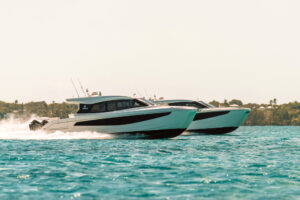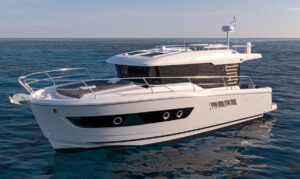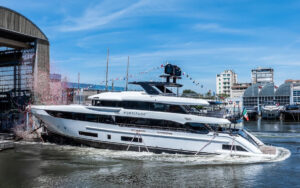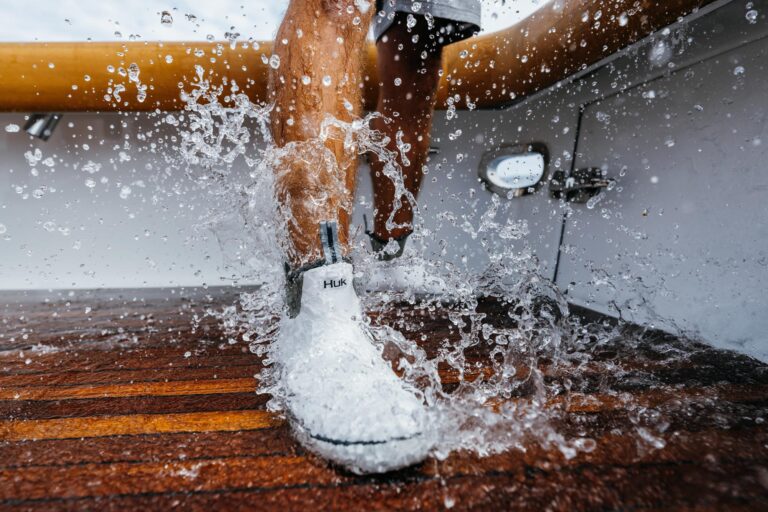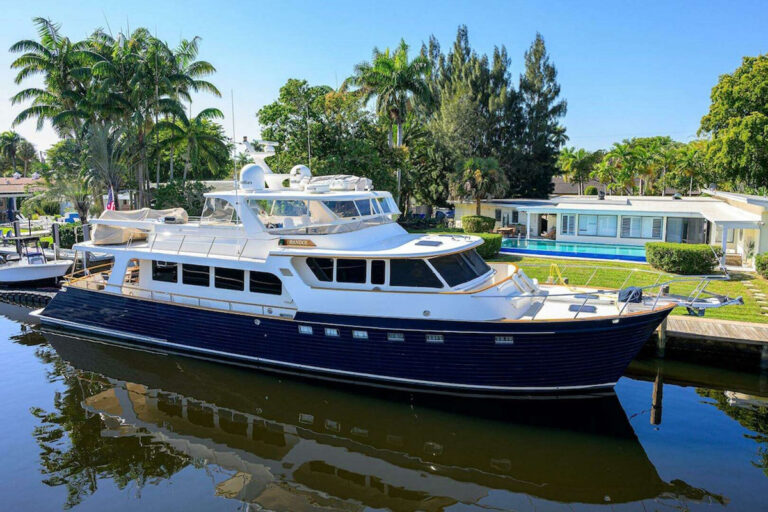For many, cruising on sailboats is a cold, wet lesson in living without. Making due with inadequate space, under-built systems and marginal sailing characteristics is the price they pay for adventure.
Judging by its new 62, Britain’s Oyster Marine Ltd. believes cruising doesn’t have to feel like a floating camping trip. I spent a week with my wife aboard the 62-foot Oystercatcher XXVI in the Caribbean and found her more akin to a luxury townhouse with a giant pool than a tent with sails.
In broad terms, a cruising boat should provide sufficient stowage for gear and provisions, and have hardy enough plumbing, mechanical and electrical systems for at least two weeks aboard. Sailhandling systems should be stout, simple and easy to manage shorthanded. The boat should be safe and reasonably comfortable under way, fast enough to minimize passage time and able to go to weather with reasonable proficiency.
The Oyster 62 is all that and then some: an able cruising yacht with plenty of offshore muscle and first-class curb appeal.
Like everyone else, I find trading the amenities of home for a fiberglass torpedo for more than a day or two requires some adjustment, but this transition was painless. The 62 was spacious and comfortable below with a layout well suited for long stays.
Oyster claims it pioneered the deck saloon with its 46 in 1978. I’d be pressed to dispute the claim, but I’d also like to hear a modern cruising sailboat builder make a good argument for not using this innovation. Broad windows on three sides transform the 62’s saloon from dark and tight to open and bright. Two of the three forward windows open for ventilation. Dining at the sprawling saloon table, looking out at a new harbor or enjoying the moon overhead is a joy no amount of 12-by-4-inch ports can provide.
Oyster is a contract builder, but the company maintains an exceptional handle on quality control. I’ve visited several of the builders Oyster uses in England and have witnessed excellent craftsmen at work. The fruits of their labors were evident throughout the 62. Joinery was sound, with fit and finish in keeping with her upper-crust pedigree and price tag (about $2.5 million). Oyster updated its joinery style a couple of years ago, and the details are elegant and bright. The 62’s interior-and that of all Oysters-is available in American light oak (Oystercatcher‘s trim), cherry or teak. Her hull is basic bulletproof fiberglass laid up in female molds, and her deck contains balsa-coring in non-load bearing areas.
The 62 has two basic layouts. The standard interior has 10 berths in five cabins, three heads with showers and the master reached via a walk-through galley to port. The optional interior has a U-shape galley and access to the slightly larger master from a passageway to starboard. Oyster, a semi-custom builder, will mix, match and modify within the design’s structural constraints.
Oystercatcher had the standard arrangement with some modifications forward. I prefer the walk-through galley, but some bluewater sailors might want the nav station closer to the master, as is the case with the optional plan. The 62 has several options forward for housing full-time crew.
I didn’t cook so much as a hot dog on our trip, but chef/mate/yachting journalist Claire Davies had no significant complaints about the galley. It was well-found right down to the standard Oyster china. Refrigeration, stowage and cooking systems were more than adequate for the extended, self-sufficient cruising many Oyster owners do. Small details, such as lee cloths in every berth and screw fittings for the bilge boards, were reminders that the 62 is made to cross oceans.
We found the master stateroom spacious and comfortable, with a private companionway opening onto the afterdeck. However, we had a bit of an issue keeping the Caribbean heat at bay. With no forward-facing hatches, and dorades that needed more breeze to be effective, we were a bit toasty on some nights. Needless to say, with the air conditioning on, we were fine. But short of leaving the generator on all night, we found ourselves having to leave the cabin door open to get sufficient ventilation. Oyster suggested the problem could be remedied with a couple of small fans or by installing a spray hood over the companionway to let it stay open all night.
By and large, Oystercatcher‘s amenities were first-rate. I’m a lifelong, unrepentant fan of the long, hot shower-a passion I often have to suppress on boats. On my first offshore trip, we heated water in a bug sprayer on the stove for a hot shower. On the Oyster, with her excellent watermaking system, we enjoyed long, hot ones whenever we needed them.
A major point of pride for Oyster, and a key part of its marketing efforts, is that many of its owners have circumnavigated. Rob Humphreys, who designed the 62’s hull, appendages and sail plan, and the Oyster in-house design team, which did the deck and interior styling, the plumbing and mechanicals, and the engineering, have created a stylish boat fitted out for serious cruising and bluewater passagemaking.
Her sturdy, well-organized mechanicals include a 185 hp Perkins diesel with dry exhaust driving a hungry, three-blade, feathering MaxpProp; A/C and D/C; watermakers capable of producing 200 liters per hour; a washer/dryer; a supplemental engine-driven bilge pump and washdown system; and air conditioning in every cabin. All through-hulls route through a manifold in a convenient cavity under the saloon sole. The watermaker strainers and main inlet strainers are there, as well.
Engine maintenance access is excellent through panels in the galley to port and the guest twin stateroom to starboard. The generator is mounted in a soundproof box under the companionway, and other panels under the settee and in the saloon sole provide easy access to the watermaker and other systems. Engine and generator noise is minimal.
The 62 displaces a brawny 74,000 pounds, and she feels it running down seas and burrowing into them. The deck saloon arrangement has the added benefit of raising the saloon sole to let tankage and batteries sit nearer the yacht’s center of gravity, which, according to Oyster, dampens the hull’s tendency to pitch in head seas.
Our trip took us from Antigua downwind to Nevis, back up to Barbuda and back to Antigua with good sailing breeze most of the time. During our sailing and motoring into the wind and seas, the boat’s motion was easy and comfortable. She had exceptional sailing manners for a big cruising boat. Despite her heft, she responded well to the helm and often pushed the needle over 10 knots on reaches and runs, and nearly that to weather in typical trade wind conditions with main and yankee (she is rigged as a cutter). With her Humphreys hull, moderate draft (8 feet, 7 inches), bulb keel and deep skeg-mounted rudder, she tracked well on all points of sail and was able to carry speed up to about 35 degrees off the wind. She was equipped with a bow thruster and is capable of about 9 knots under power.
Her cockpit, deck arrangement and sailhandling setup were exceptionally cruiser-friendly. Her primary, secondary and mainsheet winches, as well as her windlass, furlers and main halyard, were powered (the powered halyard winch is an extra). Jib sheets and furling controls were easy to operate from the cockpit. The mainsheet, traveler and backstay were all convenient to the helmsman.
The standard 62 comes with aluminum spars and a fully battened main with lazy jacks. Oystercatcher‘s rig was the lighter, optional carbon. She carried carbon poles (an option), as well.
Her twin wheels are split by a “fairway that extends from the transom to the companionway, resulting in one of the safest, easiest-to-move-about and most body-friendly cockpits I’ve seen. I love the twin wheels, but missed having a chock to brace my feet when the autopilot was off watch. A sprawling, fold-out cockpit table conceals a deep refrigerator that saves a trip below for drinks.
Davies and her husband, Stephen, Oystercatcher‘s professional crew, have done thousands of shorthanded delivery miles and had no significant complaints about her performance or handling offshore. They said she is fast and comfortable on long passages. Visibility of the sailing instruments is excellent from the helm, but Stephen said he would prefer radar and plotter screens at the helm, an obvious benefit to shorthanded cruisers.
I’ve always viewed center cockpit boats as more boxy than sexy-generally not easy on the eyes. For all they contribute to comfort and accommodations, they make me feel like I’m riding a camel. Oyster’s deck saloon/center cockpit arrangement diminishes the “hump that torches the profile of many center cockpit boats. The 62 is a well-proportioned, attractive yacht to return to after a trip ashore.
The only serious problem I had with this yacht was forcing myself into the inflatable at the end of my week aboard. That’s not always the case, is it?
Contact: Oyster Marine USA, (401) 846-7400; fax (401) 846-7483; [email protected]; www.oysteryachts.com.

